Cory Huff's Blog: The Abundant Artist Goodreads blog, page 21
April 18, 2018
Get Started Selling Art with the Ladder of Value
If you’re early in your art career and trying to figure out how to start selling your art, much less getting your income where you really want it to be, you’re going to have to start small.
A great illustration for this is the Ladder of Value.
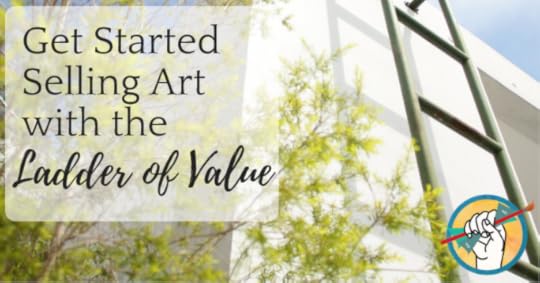
The Bottom Rungs
When you begin selling art you will be planted firmly on the bottom rungs, selling prints and, slightly higher up, small originals. You can make a small profit here, but at this point your primary goal is to get collectors in the door.
The way that you execute these early transactions will be crucial to your overall success- make sure that you obtain as much contact information as possible along with permission to contact them again.
Once you have a piece hanging on someone’s wall you have begun the cultivation of a direct relationship. Your artwork will be in front of their eyes on a daily basis. Hopefully it will be a conversation piece- they will chat about your work with friends, coworkers, and family.
During this time you will be staying front-of-mind with these collectors by sending them emails, inviting them to events, etc.
Climbing the Ladder
The next time these individuals are looking to buy a piece of art, whether it’s for themselves or perhaps as a gift, they will automatically think of you. Over time, the collectors with whom you’ve built a relationship will continue to buy larger pieces from you, and even commission work.
In this way, your art will move up the ladder of value as demand increases and you follow this direct-relationship method with every new collector you encounter.
This is the way that the majority of larger pieces and commissions are sold, and it works because of the emotional attachment and direct relationship that you cultivate with your collectors over time.
Time is the key word there- valuable collector relationships take time to build, but they will benefit you exponentially over the life of your career.
To hear more about the ladder of value and how to increase the value of your art, check out this webinar replay: How to Raise Your Art Prices. (This replay references some offerings that are no longer available near the end, but overall it’s just full of really good information that is still very relevant.)
For more on getting those first few sales and building momentum, you’ll want to read How to Get a Quick Win Selling Your Art Online.
Where would you estimate you currently are on the ladder of value?
The post Get Started Selling Art with the Ladder of Value appeared first on Online Marketing for Artists.
April 11, 2018
The 5 Rules of Art Pricing
One of the most common questions artists ask is how in the world to price their art. The good news is that it doesn’t have to be complicated. You’ll need to do some initial research to establish where your art sits in the market- what are other artists of similar experience and skill selling their work for? Once you’ve got an idea of what other artists with comparable art are doing, remember these five art pricing rules to ensure that your collectors aren’t confused, and that you’re actually making a good profit on your work and being paid what you deserve.
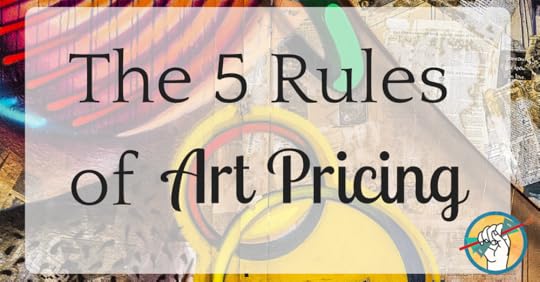
Choose a formula that works and stick to it.
Among the most common pricing formulas are linear inch or square inch pricing. In other words, you charge a set dollar amount per square inch (that’s the length times the width of your piece), or a set dollar amount per linear inch (that’s the length plus the width of your piece).
There is no right or wrong method; choose what works for you, and stick with it across every piece you create. Then, when you’re ready to increase your prices, it will be straightforward and easy for both you and your collectors to understand. Read this blog post for a helpful breakdown of various pricing formulas with examples.
Never fluctuate your pricing.
What this means is maintain your prices until you raise them. Don’t lower your prices for an outdoor art fair and then raise them back up for a gallery show. This is unprofessional and can be be harmful for gallery relationships.
Maintain consistent prices across sales channels.
You should be selling your work on your website for the same price that you sell it in a gallery, the same price that you sell it at art fairs, and the same price that you sell it at an informal private showing. As in the previous point, consistency is professional, and potential collectors will come to understand what they should expect. They will be more likely to buy your art if they recognize consistency and aren’t worried that they might be missing out on a deal through a different sales channel that they aren’t aware of.
Your originals should sell for many times the price of your prints.
If you’re selling prints, don’t price them too low. You want to be sure that not only does your price cover the cost of the print itself, but that you make a nice profit. Along with this, the price of your prints should make sense alongside the price of your originals.
Going back to the notion of clear pricing that doesn’t confuse potential collectors, prints that are priced too closely to originals will confuse collectors about the value of your work, and may make it less likely that you will sell either. More on pricing art prints here.
Never undercharge- and don’t be afraid to raise your prices.
This one can be tough to swallow, especially for artists early in their careers, and those struggling with confidence. Do some market research and see what other artists of a similar skill level and style are charging for their work, and don’t be afraid to charge a similar amount. Similarly, as demand for your work grows over time and you grow in your career, don’t be afraid to raise your prices. Your work is likely more valuable than you think it is!
Experienced artists willing to share their expertise can be a treasure trove of good advice and can help you avoid making some of the same mistakes that they made early in their careers. One such example is Melissa Dinwiddie, who has written some excellent guest blogs for us including 5 Art Pricing Lessons I Learned the Hard Way. Check it out and learn from her wisdom!
Building your art business is a hustle, to be sure. But a final note to keep in mind is this: if you are booking shows, moving work consistently, and feeling constantly busy but not seeing the income you want to see, there’s a great chance that you need to raise your prices. Don’t be afraid to do the math to ensure that you’re able to make a living from your hustle. You’re worth it!
The post The 5 Rules of Art Pricing appeared first on Online Marketing for Artists.
April 4, 2018
The Best Scanners for Fine Artists
Are you trying to figure out the best way to go about capturing images of your artwork for prints and marketing materials? Some artists choose simply to photograph their work, but others prefer to capture their images by scanning. Using a scanner means you don’t need to worry about lighting or a shaky camera, and you can be sure to capture the finest details of the work you’ve spent so much time and care creating. We’ve turned to our community to source the best scanners for scanning your fine art at home.
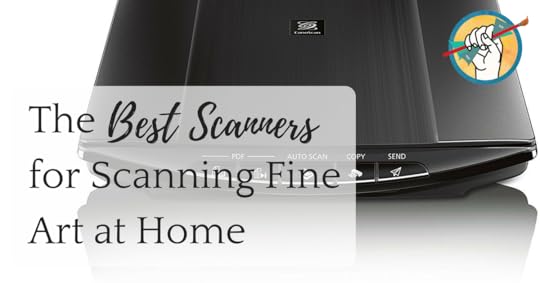
Epson Perfection V370
The Epson Perfection V370 features high dpi optical resolution as well as stitching software that will allow you to scan oversized images and stitch them together seamlessly. The Perfection V370 has highly customizable settings to accurately scan whatever kind of document you need including the options to scan in grayscale, black and white or full color, back light correction, dust removal, and adjustable brightness/contrast, color levels, etc.
The Perfection series scanners also include transparency units for scanning film negatives.
Epson Perfection V600
The Epson Perfection V600 has very high reviews among artists. It is incredibly similar to the V370 in just about every way, with a few differences: the optical resolution is very slightly higher (unlikely to make a difference for the average artist just needing to scan their work for prints or marketing materials), and the V600 allows for duplex scanning. Duplex scanning is the ability to scan two sides of a document at once.
Either of these Perfection models are great choices, but if you’re simply looking for good quality at a good price, you’ll probably be perfectly happy with the V370.
Canon Lide 220
The Canon Lide 220 has a similarly high optical resolution and 48-bit color depth. The auto scan features save you time by making automatic setting selections for optimal image correction. A cool feature of the Lide220 is the ability to store and scan vertically, for home studios with limited space available. The Canon Lide220 boasts a 10-second scan time, ideal for scanning larger batches of work at once without wasting hours of precious time.
Epson DS-50,000
Unlike the other scanners on this list, the DS-50,000 is a large-format scanner with a flatbed large enough to scan works as large as 11.7”x17”. The maximum optical resolution is 600dpi, lower than the other scanners on this list, but still higher than the minimum you’ll want to for crisp images of your work. At a significantly higher price point the DS-50,000 is an investment, but if you work larger and can’t afford the extra time required to scan your images in sections and then meticulously edit together into a single image, the DS-50,000 may be worth it to you.
Next Step: Print Your Art
If you’ve chosen to go the route of creating your fine art prints at home, you’ll also want to invest in a good printer. Check out our list of the best printers for creating professional-quality fine art prints without leaving your studio.
Did we leave out your favorite scanner? Drop a note in the comments and let us know.
The post The Best Scanners for Fine Artists appeared first on Online Marketing for Artists.
March 29, 2018
How to Delete Facebook, and What To Do Next
If the latest Facebook privacy scandal has left a bad taste in your mouth, you’re not alone. Here’s how to delete your Facebook, and some alternative social networks you can use instead to sell your art and maintain an online presence.
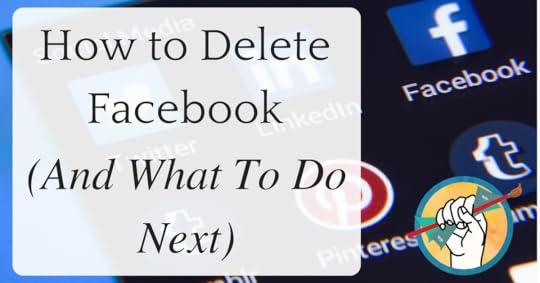
What Happened?
In a nutshell, the personal data of 50 million Facebook users was harvested via an app by a data analysis company called Cambridge Analytica. The data was allegedly used to create psychological profiles of Facebook users, which were then used to create targeted political campaigns during the 2016 U.S. presidential election, as well as well as the Brexit campaign. Whether this activity actually exerted any real influence over those elections is disputed, but the issue of the privacy breach remains.
Side note: Facebook is not the only company that has this kind of data. It’s also not the only company that has had a massive data breach. Banks, credit reporting agencies, and other companies have just as much data on you.
The scandal was that the app in question, a simple quiz, exploited a Facebook loophole that allowed the app to harvest the data of friends of the Facebook users who used the app, clearly without those friends’ knowledge or consent. Facebook maintains that this was not a “data breach”, but ultimately this is a game of semantics. Users had their data harvested without their knowledge and permission, and this information was subsequently illegally sold.
Vox.com provide a helpful illustrated diagram with the basics of this complicated story.
The Fallout
The fallout was immediate and severe- the “movement”, as some are referring to it, revolves around the hashtag #deletefacebook. Perhaps you’ve seen it? An editorial in The Guardian immediately called for everyone to delete their Facebook accounts (not just a little ironic, of course, was the icon at the bottom inviting you to share this article on Facebook).
Opinions are mixed and strong- we feel stuck between a rock and a hard place. After all, it’s 2018. It’s very, very hard to do business without being online. And in the era of social media, being online means being on Facebook. But we can’t ignore the implications of Facebook’s Terms & Conditions, which state that they can use your data to target you with “more precise” ads, track your other movements online when you’re logged in, and even use your data for research.
But there’s just no way to get around this, right? If you want to run a successful business, you have to be on Facebook.
Or do you?
How to Delete Your Facebook Account
First off, if you’ve given it a lot of thought and have decided you want out, you’ll want to decide whether you want to deactivate or completely delete Facebook. Deactivation means you won’t show up in searches and people can’t view your profile, but you can reactivate your account at any time. This would be a viable option if you want to wait it out and see what changes may come in the future, but want to take a step back from creating new data for Facebook to… use. Facebook is pretty ubiquitous, and if you’ve been using it for a lengthy amount of time, you’ll probably want to simply deactivate it for a while before making the decision to delete for good.
Deletion, on the other hand, is permanent. Your account info won’t go away immediately, and be aware that Facebook will likely retain some, if not all, of the data you produced for them while you had an account- the information that they track like ads clicked on, interactions with other accounts, etc. will still belong to them, albeit “stripped of all personal identifiers”.
If you’re ready to permanently delete your account, you’ll first want to download a copy of your info. To do this, click the arrow in the top-right corner of the screen next to the help icon. Select “settings” from the dropdown menu, and then at the bottom of the page select “Download a copy of your Facebook data.” You’ll be asked to verify your password.
Once you’ve received a copy of your data via email, let Facebook know that you want your account deleted. There will be a waiting period of a few days, during which time the deletion request will be canceled if you log back in.
What Next?
This is the million-dollar question. What social network can replace Facebook? Well, arguably if you’re considering complete deletion, you’re not looking for a 1:1 replacement. But if you still hope to sell your art online, the good news is that you have a few options. But remember that Instagram is also owned by Facebook.
If you have been using Facebook to sell your art via a business page and you’ve made the decision to switch over to something else, spend some time letting your followers know where they can find you. Keep in mind that when you create a post on your business page, everyone isn’t going to see it- that’s just how Facebook works. So you may want to:
create a few posts about it over the span of a week or so. Include images in some, perhaps a short video in another to reach as much of your audience as possible (Facebook likes videos).
Send an email to your list letting them know where they can find you from now on.
While the concerns about Facebook are very real, you don’t want to jump the gun and lose a huge chunk of your audience in the process of transitioning. So allow it to be just that- a process.
Instagram is a platform well-suited to the sharing of art for social and business purposes, and a lot of artists are finding success there. Be aware, however, that Facebook owns Instagram. So if your desire is to get as far away from the entire company as possible, Instagram is probably not the platform for you. However, Instagram is a much more limited platform. By virtue of this, you as a user are producing a smaller range of data. Regardless, read the Terms & Conditions before making your decision.
Pinterest is not a social network, but it mimics one in many ways (which may scratch that little red notification itch for you), and it can be a powerful channel for selling your artwork. Read more here about how to use Pinterest to sell your art.
Twitter is a different beast altogether, but it can also be an incredibly powerful way to get your art in front of new eyes. Once you’ve developed a following, Twitter can be a really useful tool for spreading the word about crowdfunding projects, new works, exhibitions, sales, etc. The key is in understanding what makes Twitter different from Facebook and Instagram and how to find success there. You will need to do much more than posting a link to your portfolio on occasion. (I would also personally recommend becoming familiar with the “mute” feature, or you may find yourself driven insane by empty political discourse.)
Tumblr
Tumblr is a fascinating cross between a blogging platform and a social network. A bit more raw and unregulated, it is the place many people go … to not be found. But you can grow an audience there for your art, and unlike Instagram and Facebook, there’s no algorithm deciding whose posts you see. If you follow someone, you see their posts chronologically. Simple as that. How refreshing! In spite of this, Tumblr is a bit more mysterious. Things that work on other networks to get reactions and attention will not work here. But Tumblr is very, very art friendly. Even if you decide not to use it to sell your own work, I do recommend checking it out simply for the sake of discovering new and beautiful art.
Vero
Vero is still up-and-coming, but some are billing it as “the new Instagram”, thanks to their commitment to a chronological feed and image-friendly feed structure. They aren’t without their own controversy, but worth checking out if you want to stay abreast of popular social media while simultaneously backing away from Facebook.
The Bottom Line
While Facebook is a giant with the potential to reach a massive audience, it’s no secret that it’s going to cost you to do so. The frequent algorithmic changes and the limited scope of your organic reach can be downright exhausting. Combine this with the latest data scandal, and few would blame you for considering a switch. The good news is that the real key to selling your art successfully on any social network is focus and commitment. Choose one platform, set a goal, focus on only that one platform, and you are likely to see progress no matter where you choose to put down your digital roots, so to speak.
Are you considering leaving Facebook, or do you think this is all blown a bit out of proportion? We’d love to hear your thoughts in the comments.
The post How to Delete Facebook, and What To Do Next appeared first on Online Marketing for Artists.
March 21, 2018
The Best Cameras for Photographing Artwork
Are you photographing your own artwork for your marketing materials or even for prints? There are a few factors to take into consideration to get the highest possible quality for your photographs. These include lighting, the angle of the photograph, and editing. We have an in-depth instructional post here to help you dial in those factors. But before you get that far, you’ve got to start with a camera. Recently over in The Association we had a useful discussion about the best cameras for photographing artwork, and a lot of pro artists chimed in with their favorites.

Pentax K-S2
The Pentax has a 20 Megapixel sensor, which will allow you to create enormous high-res prints from your photos. It also features a very high ISO range. You may consider this camera if you are photographing installation work, murals, or other artworks for which you cannot always control the lighting circumstances as much as you would hope.
Canon EOS Rebel T5
With an 18 Megapixel sensor, the Rebel allows for better detail on images if you need to crop them in. This is a good choice if you take photos of your large artwork and make different prints from different croppings. It also includes scene intelligent auto settings, to help take the guesswork out of situations with tricky lighting.
Canon EOS 50D
The EOS 50D features a 15.1 Megapixel CMOS sensor with noise reduction, and includes a EF 28-135mm f/3.5-5.6 IS USM standard zoom lens. It includes both automatic and manual focus. This camera has very high ISO capabilities to help make up for poor lighting, which can be helpful if you’re struggling to get the right lighting for your artwork.
Canon Powershot S110
If you aren’t ready or interested in shelling out for a DSLR, the Canon Powershot S110 is a powerful little 12.1 megapixel point-and-shoot that works just fine for taking high-quality photos. The Powershot includes a high range of customizable settings as well as an AUTO setting if you don’t want to bother or have no idea where to start. It’s sleek and compact, won’t break the bank, and includes some other cool features like Wi-Fi compatibility.
A few tips to note-
Use a tripod
It doesn’t have to be fancy or expensive! But you’ll be glad for the stabilization, especially if you want to use your photographs to make prints.
Use natural light without glare
We go over this in detail in our post on how to photograph your art. Even the fanciest camera isn’t a substitute for terrible lighting.
Do you have a favorite camera for taking pictures of your art? Let us know in the comments!
The post The Best Cameras for Photographing Artwork appeared first on Online Marketing for Artists.
March 20, 2018
Send Us Your Stories
Two weeks ago I gave a 30 minute talk on Facebook Live about how we shouldn’t try to game the social media algorithms. Follow for follow and commenting packs on Instagram only have marginal effectiveness. Facebook has a team of computer scientists who are paid to make the algorithm work the way they want it to, and you’re not going to outsmart them for long.
If you are ready to sell your art and you feel confident that you know how to sell your work, then all you need at this point is more attention. Why waste your time trying to beat the algorithm? Stop trying to get in front of just one or two people at a time and instead focus on things that will put you in front of thousands or even hundreds of thousands of people.
Back in 2015 we did a feature with Natasha Kohli, an artist based in Chicago. She landed a series of newspaper features as well as a TV spot that year. Since she couldn’t afford to hire a fancy PR firm, she did it herself. Her advice on how she did it?
Be relentless. Follow Up. Write.
That’s it. At its core, people who have great press coverage put a system in place to make sure that they are getting consistent coverage all of the time.
On March 30, we’re doing an one-day workshop on how to get more press and social media attention for your art. You can read all about it at this link.
 You don’t have to have a remarkable story to get press attention. You don’t have to be a great writer (though both of those things do help). There is a system to how these things are done, and we can show you how to make it happen for yourself.
You don’t have to have a remarkable story to get press attention. You don’t have to be a great writer (though both of those things do help). There is a system to how these things are done, and we can show you how to make it happen for yourself.
In the meanwhile…
I want your stories!
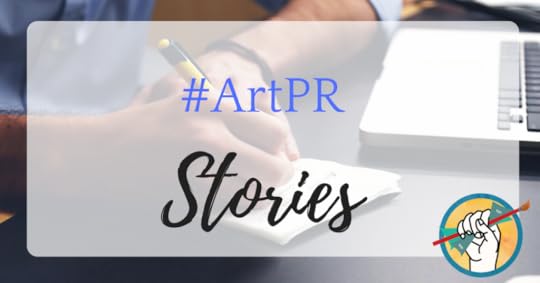
Can you share a link to a story about your art on social media? Share it on Instagram, Twitter, or Facebook. It should be something that was written up by a newspaper, blog, magazine, or a TV or radio show.
ALSO share a short story of how it happened. I’m looking for a couple sentences or a paragraph at most on how it happened – did you contact them? Did they contact you?
Use the hashtag #artpr and we will share our favorites!
I’ll share a round up in a blog post next week.
The post Send Us Your Stories appeared first on Online Marketing for Artists.
March 19, 2018
How to Sell More Art with Quizzes
If you’re on the internet in 2018, you’ve definitely taken one. A lead-gen quiz is a fun, short personality-type quiz that asks for your email address before giving you your results. You’ve probably clicked through to take these types of quizzes after seeing somebody else’s results on social media. Think “What Type of Craft Beer Are You?” or “What’s Your Ideal Vacation Spot?”
What makes these quizzes just a little different from the kinds you take on a dedicated quiz site is that these quizzes have a secondary purpose: to grow an email list (i.e. lead generation).
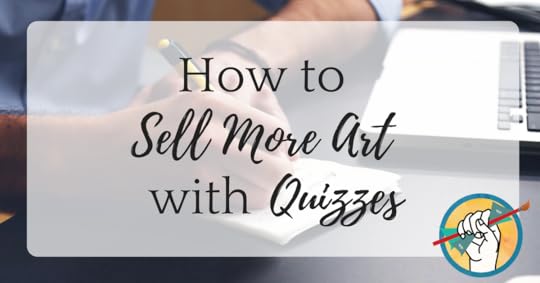
How to Use Lead-Gen Quizzes to Sell Art
If you’re doing all the “right” things to sell art through your website, you probably have some kind of an opt-in offer that bribes users to enter their email in exchange for a little goody- often a digital download of some sort. But coming up with an offer enticing enough to get people to agree to enter their email address is hard, especially because opt-in offers are now the norm. How many times have you gone into auto pilot and closed an opt-in offer pop up without even reading it? (Guilty.) If you find that the growth of your email list has stagnated, it’s probably time to try something new.
Enter the lead-gen quiz!
Embedding a quiz on your site is a fun and different way to collect email addresses. The key is to come up with something unique that will entice users to want to take the quiz.
Once they’ve taken the quiz, present them with a simple form asking for their email address, after which time they are shown their results immediately. They receive a simple, satisfying payoff that they may even share on social media, et voila, you have a new lead on your list.
Learn more about your target market
The really cool thing about using quizzes as a sales tool is that you can simultaneously use them to grow your list and to learn more about your target market. You can use the info gathered from the quiz to market more effectively, saving you time and ultimately increasing the chances of making a sale.
Here is a short example quiz called “What Color is Your Personality?” In this case you would use the questions to learn about your customers’ tastes and preferences to match them with art they’re more likely to buy.
What is your favorite fruit?
a. Citrus all the way!
b. Give me berries!
c. I love apples the most.
Where do you love to vacation?
a. I need to be by the ocean!
b. The mountains call to me.
c. I’m a kid at heart- take me to the theme park!
It’s a rainy day- where can you be found?
a. With a cup of tea and a good book, of course!
b. Walking in the rain… and maybe splashing in the puddles.
c. Doing puzzles by the window.
If a customer answered a, c, and b, respectively, you may guess that they’re an extrovert with a sunny disposition (obviously that’s not scientific- this is just an example). Perhaps you have a new series of work that is bright and cheerful, with lots of yellows. You can create an email campaign specifically to market this line of work, and drop this new email lead into that campaign.
Set up several different campaigns in this fashion, marketing different series of your work, and use your quiz to fine-tune where you drop your new leads.
Ideas for quizzes you can do
Which Abstract Painting Are You?
What Color is Your Personality?
Discover Your Art Style
What Kind of Art Should You Have On Your Wall?
What Do Your Art Preferences Say About Your Personality?
What Piece of Art Best Describes You?
Which Famous Artist Are You?
Which Famous Artwork Are You?
What Kind of (Frequent Subject of Your Artwork) Are You? (i.e. Flower, Horse, etc.)
Are You Abstract, Impressionist, or Realist?
A Quiz Tool We Like: Interact
Interact is a tool that allows you to create and embed quizzes on your website to generate leads. There are over a hundred quiz templates available to begin with, or you can create your own from scratch. The design of the quizzes is entirely customizable, so you can match the look of your website and branding.
Here’s what we really like about Interact, and why we recommend it more than a simpler quiz builder: the purpose of Interact is to generate leads for you and grow your sales. The in-depth features include the option to present different questions depending on how previous questions are answered (they call this branching logic), an opt-in form builder, analytics so you can see how your quizzes are performing and make tweaks as necessary, and optimization for mobile devices.
Using quizzes to generate new leads for your art business and to learn more about how your ideal customers think is a tool with a huge amount of potential for growing your list and increasing your sales. It’s absolutely worth a try.
Disclosure: We receive an affiliate commission from Interact if you sign up for their paid membership. This helps us continue to create great content like this for you.
Have you used a quiz on your website? How did it go? Let us know in the comments.
The post How to Sell More Art with Quizzes appeared first on Online Marketing for Artists.
Is Vero the New Instagram?
In the past, we have seen a few platforms arise with the potential to challenge Instagram’s position as the internet’s primary photo-sharing app, most of them have come to nothing. Yet, last week the artistic community was abuzz with news of latest contender, Vero. This attention was not just confined to talk, as the three-year-old app saw it’s membership increase from the relatively stable 150,000 users to over 3 million in one week (a whopping 1900 percent increase!). Considering these remarkable figures, it makes sense to take a closer look at just what is causing all the excitement about Vero.

What has caused the explosive growth?
Like all direct competitors, the rise of Vero is of course inextricably linked to the behaviour of Instagram themselves. In this case, they appear to have alienated their users by introducing some very unpopular algorithms. The artistic community is up in arms over the social media giant’s decision to use algorithms to rank their posts in order of popularity rather than chronologically. Though this may not seem like a big deal, it can actually have a significant impact on the way that your work is being exposed online. Part of the algorithm’s effect is that it controls who gets to see your work on their newsfeed (based on who the post is most relevant to). This means that only about 15 percent of your followers will see each new photo – a dramatic challenge to your online exposure. Furthermore, it also means that you as an artist will be limited in the amount of posts you can see from the people that you follow further limiting your access to creative inspiration.
So what’s new about Vero?
As a fellow image-sharing app, Vero is undeniably akin to Instagram in many ways. You can follow people, post images and edit them with filters in a very similar manner, however, there are a few key changes to note. In direct contrast to Instagram, Vero promises to refrain from using both adverts and algorithms so you can use the platform safe in the knowledge that your data is not being passed onto a third party. In the same vein, Vero boasts more developed privacy settings giving you the option to keep your posts: entirely private, shared with your close friends, friends, acquaintances or followers – effectively allowing you to manage a personal and professional account all in one place. The final notable difference, is the platform’s ability to allow you to share books, TV and music that you have enjoyed (as well as your pictures) so you can develop an online persona that would otherwise have to come from a blog.
How can these changes allow you to sell more work?
Well here are the essential points:
Lack of algorithms. As highlighted above, this decision means that users of the platform are entirely in charge of their own content. By ordering your posts chronologically, you (and everyone else) can see the progress of your own portfolio. It also means that when you post something all your followers will have chance to see it – not just 15%!
Choosing your audience. By allowing you to choose who gets to see your work (friends vs followers etc.), the platform gives you the power to cultivate your own exposure as a professional. You can, for example, set your main clients as ‘close friends’ and then send them bespoke posts.
Linking to your work. This innovation is absolutely crucial for anyone looking to sell their work online. Unlike Instagram, Vero allows you to link your work to in-app sales, so that if your followers see something they like they can purchase it right away. Careful though as Vero will take a cut of your sales here!
In other words, people are excited about Vero because it gives more control over your professional work whilst allowing people to make direct purchases on the platform.
Should you change your allegiance from Instagram?
Undoubtedly, Vero’s star has risen remarkably quickly and there’s always a danger in such cases that it will dwindle after a short lived blaze. Yet Vero is, in many ways, a totally unique situation. The rapid sign up rate means that 2850000 out of its 3 million or so users are new and therefore likely to be actively exploring the platform. This gives you, as a professional artist, a fantastic opportunity to expose your work to an enormous body of people. Signing up now, in its rapid phase of growth, could just give you that edge that you are looking for. Since the app is currently free to download (they may introduce an annual fee in the future) you might as well strike while the iron is hot and give it a go – there certainly seems to be little to lose!
Editorial Note: TAA team here! There is currently some controversy over how difficult it is to delete one’s Vero account once you’ve signed up. Just a quick reminder: before you jump on to any new social network and upload images of your copyrighted work or share sensitive personal information, please make sure to do your research in advance, and be sure to read the Terms and Conditions before you sign up.

Flora Dallas is a content writer for Fat Lama the world’s fastest growing peer-to-peer rental marketplace. The platform, available in the US and UK, allows people to rent almost anything easily and cheaply from people nearby. It’s mission is to enable people to share and monetize their unused possessions, increasing the efficiency of both the consumer and the planet’s resources.
The post Is Vero the New Instagram? appeared first on Online Marketing for Artists.
March 15, 2018
How to Run an Instagram Flash Sale
If you’re using Instagram to sell your art, a flash sale can be a great way to excite your followers and quickly burn through some excess inventory. A flash sale is just a quick time-sensitive sale that runs for only a single day, or even just a few hours.
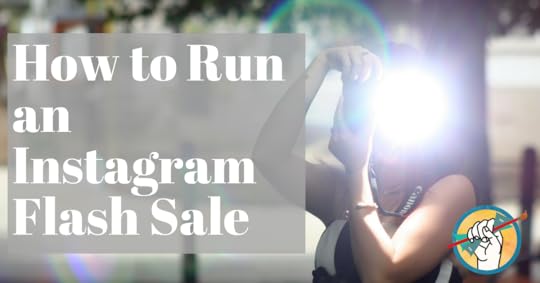
How to Run an Instagram Flash Sale
Set a goal & make a plan. Pay attention to what times of day your target market is most active on Instagram. If you are using an Instagram business account, Instagram provides this info in the Insights section. Decide how much you want to make, and how many prints or original pieces you’ll need to sell to meet your goal.
Write your posts in advance, including your hashtags, so that you can copy/paste at the appropriate time (or schedule your posts to go out automatically if you’re using Hootsuite and Instagram for Business).
Successful flash sales offer deep discounts. If you’re not comfortable discounting your artwork, that’s totally okay. If you don’t want to discount your original work, a flash sale can be used to burn through an excess inventory of prints. You could also experiment with bundling prints and originals together. You can also use the flash sale method to debut new originals, no discount necessary.
Use a hashtag. A hashtag can be helpful if you’ll be publicizing your sale ahead of time.
Decide whether it will be a surprise. Some businesses use flash sales as a pleasant surprise to their regular followers. Others hold a brief sale at the same time/day every week or month. If you have an active audience on Instagram, you can even experiment with offering new collections for sale at the same time and day at whatever time interval it takes for you to make new work.
Ensure customers can order quickly. Make sure you have your sales process in place from start to finish before beginning the sale. An easy and common method is to ask customers to comment with their Paypal email- the first to comment with their email address gets the item, and you invoice them immediately. If you choose to go this route, have your invoices ready in Paypal so all you have to do is plug in their email address and hit send. Buyers will appreciate the efficiency.
Leverage other people to draw attention to your sale. Get more eyes on your sale by leveraging other people’s people to post about your sale. Need help figuring out how to do this? We’re running a live workshop on March 23 for How to Sell Your Art Online 301: PR & Media Outreach.
Have you ever sold your work with a flash sale? We’d love to hear about it in the comments! If you’re on the fence about using Instagram to sell your art, check out this post on choosing the right social media platform.
The post How to Run an Instagram Flash Sale appeared first on Online Marketing for Artists.
March 12, 2018
You Can’t Beat the Instagram Algorithm
Last week, I spoke on Facebook Live about just how futile it is to try to outsmart the Instagram algorithm (or Facebook, Youtube, or Twitter or whatever).
What can we learn about social media feed algorithms from Google’s algorithm?
I started doing search marketing in 2007, working for a small internet marketing agency. When Google first started, all you had to do was add some text to your website’s code to tell Google what your site was about, and boom, you ranked on the first page of Google for your search term.
Savvy web developers started stuffing keywords into their websites to rank for the searches they wanted to rank for. Once everyone caught on to that, Google started making tweaks to their ranking algorithm. They looked at links. They looked at how many people mentioned your website. They looked at technical things like page load speed. They looked at how much time people spent on your website.
Then, in 2009, Google started giving preference in ranking to large brands. This was in part due to the fact that everyone recognized those brands, and in part due to the fact that large brands have more marketing dollars to spend on things like purchasing links.
Now, in 2018, Google’s search rankings are, in large part, static. New players don’t rank for competitive search terms in industries like travel, fitness, or ecommerce.
We are at an inflection point in social media very similar to what happened to Google. Back when Facebook first started, you could get tons of traffic and attention just by putting up something mildly interesting. Then people started engineering clickbait articles and doing things like tapping the screen to get you to turn the sound on.
With all due respect to my colleagues, reverse engineering these organic algorithms that change constantly is exhausting and annoying. I enjoy doing it, but most people don’t.
On top of that, most of these “beat the algorithm tricks” only bring marginal increases in sales.
So what can you do?
Other People’s People
One thing that has worked well for me, and for artists that I know, is to leverage other people’s people.
Bloggers, journalists, and other influencers with large followings can make a huge difference in your business by sharing and recommending your art. And the reality is that its not as hard as you think to get them to share your stuff. One artist just emailed me to tell me that this Summer she’s doing an event where over 100,000 people will see her work on display, and influencers are coming to her to ask if they can participate.
On March 23, we are doing a one day workshop where we will teach you all about getting attention from influencers. You can learn more about that at this link.
The post You Can’t Beat the Instagram Algorithm appeared first on Online Marketing for Artists.
The Abundant Artist Goodreads blog
- Cory Huff's profile
- 31 followers



